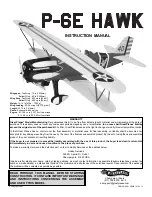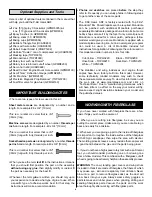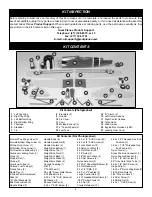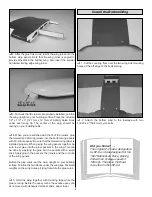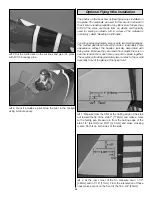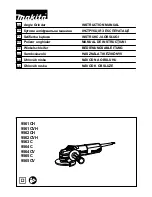
❏
7. Now that the cowl is properly mounted to the fuselage
you can finish the hole for the engine head. You can also
make a template from thin cardboard to locate the hole for
the exhaust and needle valve.
❏
8. Also, while you have the cowl removed, apply a couple
of drops of thin CA to each of the four cowl mounting holes
in the fuselage to harden the wood.
❏
1. Remove the components from inside the fuel tank.
Install the three aluminum tubes in the fuel tank stopper. You
will need to use a hobby knife to open the third hole in the
rubber stopper. Slide the small metal plate over the tubes and
thread the screw into the plate until it makes contact with the
back of the rubber stopper. Do not tighten the screw.
❏
2. Carefully bend one of the long tubes so that it will
angle up toward the top of the fuel tank when inserted. Do
not kink the tube. Mark a “P” on the outside of the front plate
to designate pressure.
❏
3. Install a piece of fuel tubing on each of the other two
tubes. Attach a clunk on the ends of the tubes. Mark a “C” on
the outside of the front plate by the short tube, designating
carb. Mark an “F” by the remaining tube, designating fill.
❏
4. Insert the tank stopper in the fuel tank so that the bent
tube is towards the top of the fuel tank. Check that the two
clunks are able to move freely when the stopper is inserted
completely. Then, tighten the screw in the stopper to seal the
fuel tank. Write “top” on the side of the fuel tank where the
pressure tube sticks up.
❏
5. Install the three pieces of fuel line on the three aluminum
fuel tubes sticking out the front of the fuel tank. Write on the
firewall box which color of tubing goes to the carburetor, fill and
pressure. Insert the fuel tank into the fuel tank compartment,
routing the fuel line out to the engine. Make sure the top of the
tank faces the top of the fuselage. Insert the stopper portion of
the tank in the hole in the forward former.
Install the Fuel Tank
15

